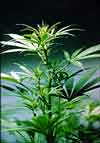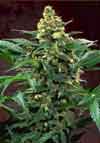 Marijuana - (Weed, Bud,
Chronic)
Marijuana - (Weed, Bud,
Chronic)
 Marijuana - (Weed, Bud,
Chronic)
Marijuana - (Weed, Bud,
Chronic)


Marijuana is the most common illegal drug used in Australia. It is made from the dried flowers and the leaves on the plant called Cannabis Sativa. Other names for marijuana are GRASS, CANNABIS, MULL, POT, DOPE, CHRONIC Etc...
Marijuana can look like dried herbs or tea. Sometimes it contains seeds or twigs. It can be grey, green or brown in colour.
Marijuana is usually smoked in hand rolled cigarettes called "joints" or in water pipes called "bongs". Sometimes it is mixed with food such as cakes and cookies and eaten.
Cannabis is a plant that has been grown by humans for many centuries maybe longer and used plenty of different ways. This plant is one of the most versatile plants known to mankind. It has been used for centuries in the production of hemp fibre. Marijuana has been used as a medicine and an intoxicant for centuries in many parts of the world. In the U.S, usage of the drug has been prohibited since the early 1900's.
In spite of these laws, drug use became widespread during the 1960's & 1970's especially among young people. Between "1969 & 1978" the US federal and state governments reduced the criminal charge for carrying small amounts of marijuana, from a felony to a misdemeanor.
Surveys indicated a decline in the usage of the drug during the 1980\'s as more people became aware of the drugs possible harmful effects.
Deta-9 tetrahydrocannabinol (THC) is the psychoactive ingredient in cannabis, It is one of more than 60 chemicals found in the cannabis plant and affects a persons mood and thoughts once smoked or eaten. Its the THC that make a person feel stoned, bent, mellow, high, whacked or off their face. This means you experience a change in mood and may see things in a different way.
Some parts of the plant contain a higher level of THC. For example, the flowers or buds have more THC than the stems or leaves.
When THC enters your bloodstream (either via your lungs if smoking cannabis or your stomach lining if you eat it) it gets pumped to your brain where it attaches itself to specific cannaboid receptors. These receptors are thought to influence a persons emotions, pain, memory and motor skills. We also have two natural brain chemicals called anandamide and 2-AG, which bind to the same receptors as THC. Research is still trying to determine the role of anandamide and 2-AV in normal brain function.
The psychological reaction known as a high consists of changes in the uses feelings and thoughts. The effects of marijuana will depend on:
how much you take
how strong the marijuana is
how the marijuana is taken (joint, bong, food)
your size, weight, and health
your mood
your experience with marijuana
whether marijuana is taken with other drugs
whether you are alone or with other people, at home or at a party.
If you have a small amount of marijuana, the effects can last for three to five hours. You may:
feel unusually well or happy.
do or say things which you normally wouldn't.
talk and laugh more than usual.
have bad balance and coordination
find it hard to concentrate
feel hungry
have a faster heart rate
have red eyes
focus on one particular thing and ignore all other things.
These effects usually lead to feelings of slowing down and sleepiness.
If you take a large amount of marijuana. You may:
feel confused
be restless
feel excited
see or hear things which are not there
feel anxious or panicky
feel distant or separated from reality.
Marijuana can also cause problems with:
remembering things
thinking clearly
movement
ability to do things like drive or operate machines.
These symptoms usually disappear when the effects of marijuana wear off.
Many people have urged an investigation of the possible medical use of marijuana and the chemicals in it. In 1980 the U.S Food and drug Administration (FDA) approved the limited use of THC pills to control nausea brought on by anti-cancer medicines.
Under a tightly regulated investigational program, the FDA has provided marijuana cigarettes to a few cancer and glaucoma patients. In 1985, the FDA approved Marinol, a drug containing THC for use under a physicians supervision.